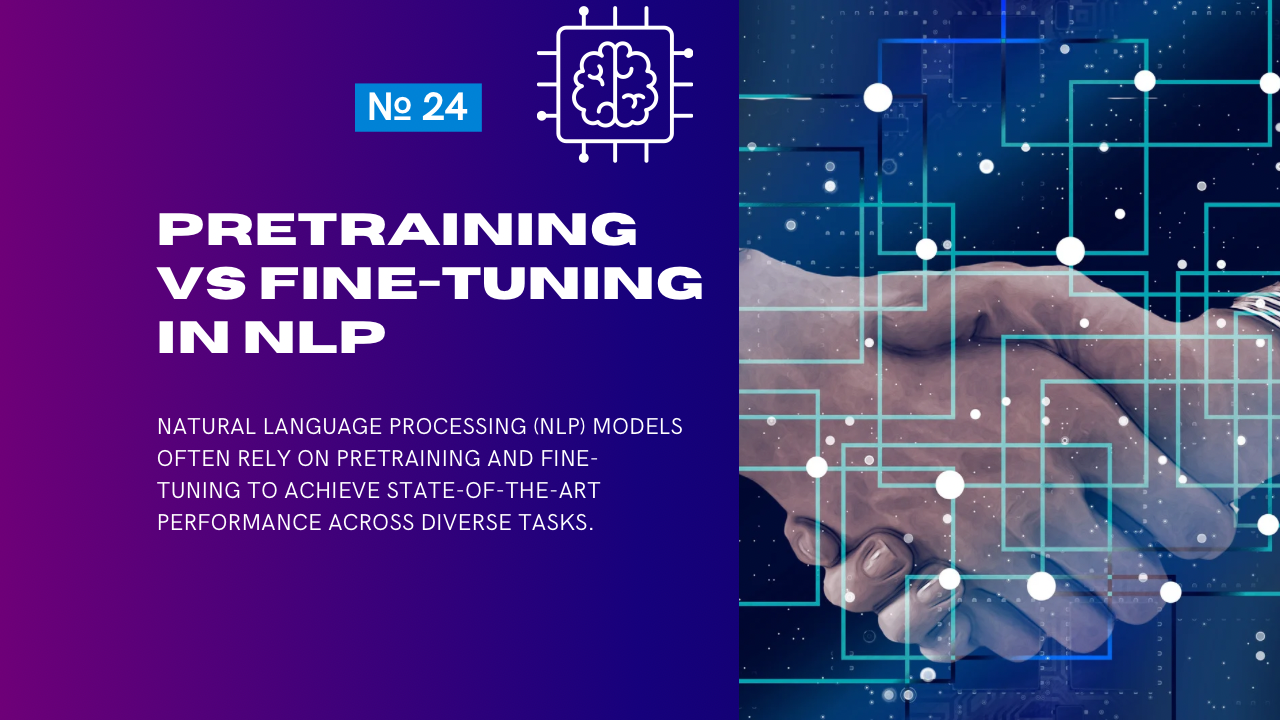Natural Language Processing (NLP) models often rely on pretraining and fine-tuning to achieve state-of-the-art performance across diverse tasks. Both techniques play distinct roles in model development, and understanding when to use them is crucial for building efficient and accurate NLP systems.
Definitions Pretraining
What It Is :Pretraining involves training a model on a large, general-purpose dataset to learn language representations.
Examples: GPT, BERT, RoBERTa, T5.
Objective :Capture general linguistic patterns, syntax, and semantic structures.
Fine-Tuning
What It Is :Fine-tuning adapts a pretrained model to a specific task or domain by training it on labeled data for that task.
Examples: Sentiment analysis, question answering, summarization.
Objective :Specialize the general knowledge learned during pretraining for specific use cases.
Pretraining: When and Why to Use It When to Use Pretraining
Large-Scale Custom Data :
When you have access to a massive amount of domain-specific text (e.g., legal documents, medical records).
Example: Training a domain-specific language model (e.g., BioBERT for biomedical texts).
New Languages :
For low-resource or less-studied languages not covered by existing pretrained models.
Example: Pretraining a transformer for Swahili if no pretrained model exists.
Proprietary Needs :
If public models don’t meet specific requirements due to privacy, proprietary data, or edge-case handling.
Benefits of Pretraining
Captures General Language Understanding :Learns universal linguistic features like grammar and syntax.
Improves Transfer Learning :Provides a strong base for downstream tasks.
Customizability :Tailors the model to unique data distributions or niche domains.
Limitations of Pretraining
Resource Intensive :Requires large datasets, significant compute power (e.g., TPUs, GPUs), and time.
Complexity :Challenging to implement without expertise in distributed training and optimization.
Fine-Tuning: When and Why to Use It When to Use Fine-Tuning
Task-Specific Needs :
When you have labeled data for a specific NLP task (e.g., named entity recognition, sentiment analysis).
Example: Fine-tuning BERT for detecting spam in emails.
Domain Adaptation :
When applying general-purpose pretrained models to domain-specific tasks.
Example: Fine-tuning GPT on financial news for sentiment analysis.
Low-Resource Scenarios :
When limited labeled data is available, leveraging transfer learning from pretrained models.
Example: Fine-tuning RoBERTa on 100 annotated medical records.
Benefits of Fine-Tuning
Efficiency :Requires significantly less data and compute power compared to pretraining.
Faster Training :Builds on the pretrained model, speeding up convergence.
Flexibility :Easy to adapt state-of-the-art models for specific tasks.
Limitations of Fine-Tuning
Overfitting :Risk of overfitting on small datasets if not regularized properly.
Task Dependency :Performance depends heavily on the quality and quantity of labeled data.
Comparison: Pretraining vs Fine-Tuning Aspect Pretraining Fine-Tuning Objective Learn general-purpose language representations. Adapt to specific tasks or domains. Data Requirements Large-scale, unlabeled text data. Task-specific labeled data. Compute Requirements High (multi-GPU/TPU clusters). Moderate (can be done on a single GPU). Flexibility General, reusable for multiple downstream tasks. Task-specific and tailored. Cost Expensive (time, compute). Cost-effective for most use cases. When to Use For domain-specific pretraining or new languages. For adapting pretrained models to tasks.
Strategies for Combining Pretraining and Fine-Tuning
Use Pretrained Models :
Start with publicly available models (e.g., BERT, GPT-3, RoBERTa, T5) and fine-tune them for your task.
Example: Use Hugging Face’s Transformers library to fine-tune BERT on sentiment analysis.
Intermediate Fine-Tuning :
Fine-tune a pretrained model on a domain-specific corpus before task-specific fine-tuning.
Example: Fine-tune BERT on legal text, then fine-tune further for legal case classification.
Continual Pretraining :
Extend the pretraining of a general model on your custom dataset to improve domain understanding.
Example: Pretrain GPT-2 on medical research papers to build a domain-specific language model.
Example: Fine-Tuning with Hugging Face Transformers from transformers import AutoTokenizer, AutoModelForSequenceClassification, Trainer, TrainingArguments
from datasets import load_dataset
# Load pretrained model and tokenizer
model_name = "bert-base-uncased"
tokenizer = AutoTokenizer.from_pretrained(model_name)
model = AutoModelForSequenceClassification.from_pretrained(model_name, num_labels=2)
# Load dataset
dataset = load_dataset("imdb")
encoded_dataset = dataset.map(lambda x: tokenizer(x["text"], truncation=True, padding=True), batched=True)
# Define training arguments
training_args = TrainingArguments(
output_dir="./results",
evaluation_strategy="epoch",
learning_rate=2e-5,
per_device_train_batch_size=8,
num_train_epochs=3,
weight_decay=0.01,
)
# Define Trainer
trainer = Trainer(
model=model,
args=training_args,
train_dataset=encoded_dataset["train"],
eval_dataset=encoded_dataset["test"],
)
# Train and evaluate
trainer.train()When to Choose Pretraining, Fine-Tuning, or Both Scenario Recommendation You have large, unlabeled domain-specific data. Pretraining + Fine-Tuning You have limited labeled task-specific data. Fine-Tuning Only You are working in a resource-constrained environment. Use pretrained models directly. Your task involves a new, low-resource language. Pretraining on language-specific data, then fine-tune.
Key Takeaways
Pretraining is resource-intensive and ideal for building general-purpose models or domain-specific models from scratch.Fine-Tuning is faster, cost-effective, and suitable for adapting pretrained models to specific tasks.For most NLP tasks, fine-tuning a pretrained model (e.g., BERT, RoBERTa) is sufficient and recommended.
Combine strategies when working with domain-specific data or specialized tasks.
